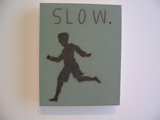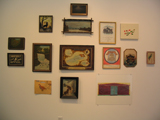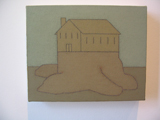 Viewing
the work of an artist who has been making art for decades is like
looking at an iceberg. You see the little part that is showing but
not the hidden part, which is years of study, making art, learning
about oneself, and inventing.
Viewing
the work of an artist who has been making art for decades is like
looking at an iceberg. You see the little part that is showing but
not the hidden part, which is years of study, making art, learning
about oneself, and inventing.
The work of John Dilg, on exhibit at St. Ambrose University's Catich Gallery through September 29, may seem simple at first glance, but that is only the tip, the obvious part. Part of the reason is that as one paints for a long time, one begins to consciously and unconsciously shed the unnecessary. What remains is the essential. Dilg's work is simple, spare, and verges on being a visual language, like hieroglyphs or ideograms. There is a subtle humor about them, and the dozen small paintings spread around the room feel like the characters or phrases of this visual language.
Dilg's palette is one of muted golds, greens, and turquoises, and objects are drawn with spare black lines to represent scenes and objects that beckon us to recall such glimpses or situations from our own lives. The humor arises from the innocent style in which they are rendered, and also from the chance remembrances represented, such as the "Slow Children Playing" sign that is translated into the icon of a running boy in knickers, who is every child and childhood itself.
 The
artist has included a rare insight into his work in this show: source
and inspirational material that is grouped together on one wall. It's
a good idea to look at this before viewing the show, and then again
afterward to see how the images left their influence, both directly
and indirectly.
The
artist has included a rare insight into his work in this show: source
and inspirational material that is grouped together on one wall. It's
a good idea to look at this before viewing the show, and then again
afterward to see how the images left their influence, both directly
and indirectly.
The grouping includes such diverse items as signs, maps, old advertisements, and "outsider" paintings. (Often called "primitive" art or "naïve" art, and closely related to folk art, "outsider" art is made by a person who has little or no art training, but simply has a desire to make art with no thought for sophistication of expression. Think of plywood cutouts of old ladies bent over pulling weeds or whirligigs or graffiti.)
The collection of influences is rustic, naïve, and nostalgic, and suggests a secondhand-store Americana aesthetic. Dilg says of his source material, "Don't read the associations between the sources and my paintings too literally; the sources are, collectively, an intimate space that I like to inhabit, and no one image ever successfully survives, in total, the transport to a painting."
In addition to the source material, we experience a drawing on canvas (without a title) that contains many of the images from his paintings gathered into one larger composition, establishing the ambiguous relationship between this composite drawing and the individual images. It bears a similarity to a hieroglyphic story incised on an Egyptian tomb, and is just as likely to raise questions about its meaning.
 The
painting Self-Employed
is a simple, almost childlike drawing of an iconic house in a
flattened perspective sitting atop what appears to be a high point or
a tree stump. Drawn with the same simple line as the other pieces,
and using the same earthy colors, it seems to be a piece about
autonomy, home, and roots.
The
painting Self-Employed
is a simple, almost childlike drawing of an iconic house in a
flattened perspective sitting atop what appears to be a high point or
a tree stump. Drawn with the same simple line as the other pieces,
and using the same earthy colors, it seems to be a piece about
autonomy, home, and roots.
John Dilg is the head of the painting department at the University of Iowa, and has exhibited in this country and abroad. His work embraces the straightforward aesthetic behind outsider art, which is, in many ways, the antithesis of an academic style and the craft it implies, and returns to the reasons people began painting in the first place - which is simply a need to express.
This is a show worth seeing, to experience the delicate simplicity with which the paintings are made, and to experience the implied stories that lie within the paintings, which are about our lives, collectively and individually.
Don't, however, expect to find a clear narrative, and keep in mind that creating questions in the mind of the viewer is an important role of the artist in the 21st Century, and that ambiguity is really a door left open to invite you in. It beckons you to be a participant, not just an observer.
A reception for John Dilg will be held on Friday, September 8, from 5 to 7 p.m. at the Catich Gallery, located in St. Ambrose University's Galvin Fine Arts Center. The exhibit runs through September 29.










